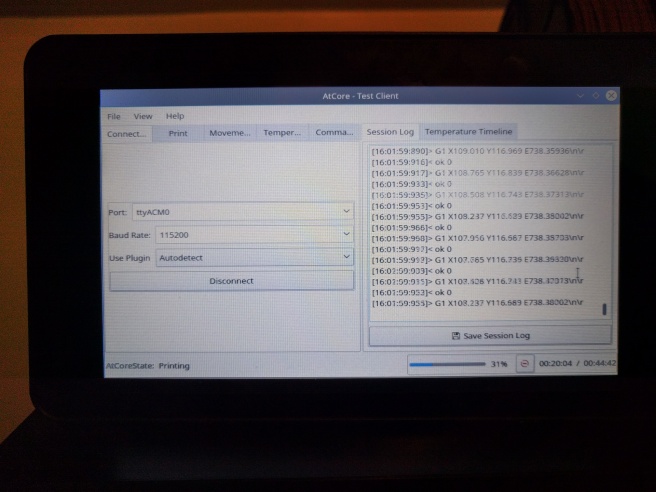The Machine
The Raspberry Pi3 is a small single board computer that costs around $35 (USD). It comes with a network port, wifi , bt , 4 usb ports , gpio pins , camera port , a display out, hdmi, a TRRS for analog A/V out. 1GB of ran and 4 ~1GHz armv8 cores Inside small SOC. Its storage is a microSd card they are a low cost and low power device. The Touchscreen kit is an 800×480 display that hooks to the Gpio for touch and dsi port for video. To hold our hardware is the standard touch screen enclosure that often comes with the screen if you buy it in a kit.
Raspian?
Most of the time it is sufficient to run Raspian the official distro that is made for the raspberry pi. raspian is a fork of debian as much like debian it has some old packages. In order to build AtCore (with the gui) you need at least qt5.8 raspian comes with 5.7. This is not a show stopper but compiling qt does take quite some time and can easily take a week if we were to build it on the rpi itself. Setting up a cross complier will save you a lot of time but even on my fastest machine it will still take some hours to build qt for the pi. I decided it would instead be faster to install a completely unsupported OS on the device. I was going to install install arch linux on the rpi. Arch is a rolling distro that ships with qt 5.10.
Doubly Unsupported
Arch linux on the raspberry pi is what you might call “doubly unsupported” That is that the raspberry pi foundation does not support running arch on the pi. You only get support from the arch community. Arch Linux is not officially supported on platforms other then x86_64 the rpi running on arm. Worry not for the Arch community has some forks such as archlinux-arm this is what we will be installing. Like most things arch you get some instructions. After getting the os installed its still arch so you only get a cli interface on your first boot and are left to set up the rest of the system.
Post Install
For my system I installed plasma-meta , xf86-video-fbturbo-git and sddm. With those I was able to have a working plasma shell. I also installed dolphin, kate and konsole as well as the few atcore dependencies. I then added my user to the uucp group so I was able to r/w to serial devices and restarted. When all the dependencies are installed you can proceed to build atcore. Since this is arch we can simplify the building part just by using atcore-git from the aur. Im Happy to say it took only minutes and 48 seconds to build atcore-git on the rpi. I then used pacman to install the atcore-git package and it was time to see how our gui was looking on such a small screen.
The Result
At first the contents of the atcore-gui spill off the screen due to the way our docks are tabbed, however since they are docks you can just adjust them to make a quick usable interface. After adjusting the gui AtCore worked exactly the same as it does on other systems. Below you can see a picture and video.

Can do better
There is lots of room for improvement. Atcore-gui does not save any settings. You’ll need to move the docks around each time you launch the program. Atcore-gui can not automatically connect to a device on launch. Again for reasons of not saving settings This gui is of course not really made for use on a touch screen and it does seam to work good enough to use. Some non atcore changes on the system itself would be nice. A few services running on the pi would improve this over all. Mjpeg streamer or another method of streaming video from the attached camera on my printers extruder. Uploads are done via stfp that’s not always easy for everyone. The pi does not launch atcore-gui on start up . Small stuff like this could easily be adjusted. I was really just playing around to see how atcore ran on the rpi. I was very happy when this worked well.
> raspian is a fork of debian as much like debian it has some old packages. In order to build AtCore (with the gui) you need at least qt5.8 raspian comes with 5.7. This is not a show stopper but compiling qt does take quite some time and can easily take a week if we were to build it on the rpi itself. Setting up a cross complier will save you a lot of time but even on my fastest machine it will still take some hours to build qt for the pi. I decided it would instead be faster to install a completely unsupported OS on the device.
…Or you could just add Debian testing repository and install Qt 5.9. (There is also Qt 5.10 in experimental.)
LikeLike
That is a good point i could have used debian testing.
LikeLike
Very cool!
LikeLike